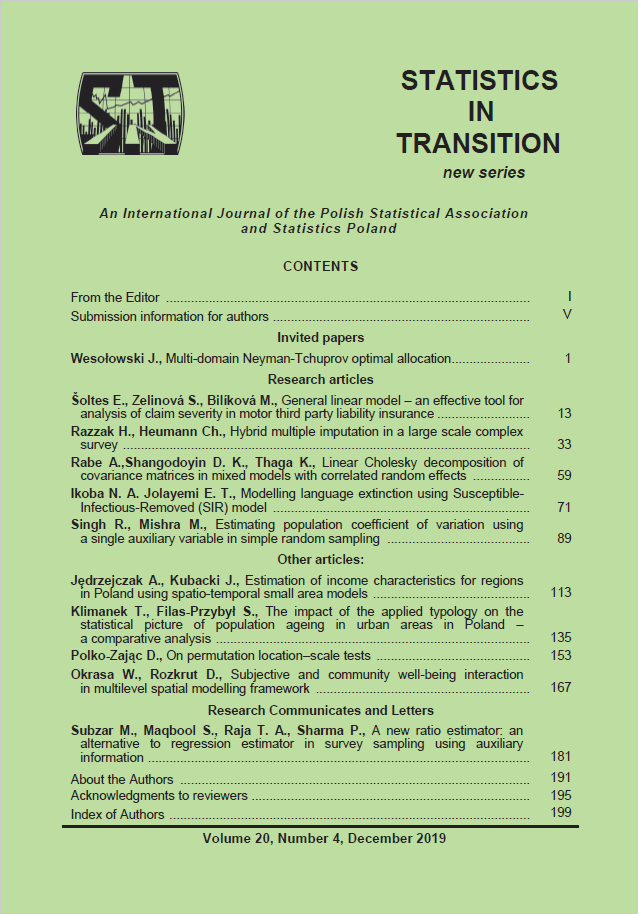ARTICLE
ABSTRACT
This paper proposes an improved estimation method for the population coefficient of variation, which uses information on a single auxiliary variable. The authors derived the expressions for the mean squared error of the proposed estimators up to the first order of approximation. It was demonstrated that the estimators proposed by the authors are more efficient than the existing ones. The results of the study were validated by both empirical and simulation studies.
KEYWORDS
coefficient of variation, simple random sampling, auxiliary variable, mean square error
REFERENCES
AHMED, S. E., (2002). Simultaneous estimation of Co-efficient of Variation. Journal of Statistical Planning and Inference, 104, pp. 31–51.
ARCHANA, V., RAO, A., (2014). Some Improved Estimators of Co-efficient of Variation from Bi-variate normal distribution: A Monte Carlo Comparison. Pakistan Journal of Statistics and Operation Research, 10(1).
BREUNIG, R., (2001). An almost unbiased estimator of the co-efficient of variation. Economics Letters, 70(1), pp. 15–19.
DAS, A. K., TRIPATHI, T. P., (1981). A class of estimators for co-efficient of variation using knowledge on coefficient of variation of an auxiliary character, In annual conference of Ind. Soc. Agricultural Statistics, Held at New Delhi, India.
DAS, A. K., TRIPATHI, T. P., (1992). Use of auxiliary information in estimating the coefficient of variation, Alig. J. of. Statist, 12, pp. 51–58.
FINITE POPULATION-II, Model Assisted Statistics and application, 1(1), pp. 57– 66.
KHOSHNEVISAN, M., SINGH, R., CHAUHAN, P., SAWAN, N., SMARANDACHE, F. (2007). A general family of estimators for estimating population means using known value of some population parameter(s), Far East Journal of Statistics, 22(2), pp. 181–191.
MALIK, S., SINGH, R., (2013). An improved estimator using two auxiliary attributes, Appli. Math. Compt., 219, pp. 10983–10986.
MISHRA, P., SINGH, R., (2017). A new log-product type estimator using auxiliary information, Jour. Sci. Res., 61(1&2), pp. 179–183.
MURTHY, M. N., (1967). Sampling theory and methods, Sampling theory and methods.
PATEL, P. A., RINA, S., (2009). A Monte Carlo comparison of some suggested estimators of co-efficient of variation in finite population, Journal of Statistics sciences, 1(2), pp. 137–147.
RAJYAGURU, A., GUPTA, P., (2005). On the estimation of the co-efficient of variation from SINGH, H. P., TAILOR, R., (2005). Estimation of finite population mean with known coefficient of variation of an auxiliary character, Statistica, 65(3), pp. 301–313.
SINGH, H. P., SINGH, R., (2002). A class of chain ratio- type estimators for the coefficient of variation of finite population in two phase sampling, Aligarh Journal of Statistics, Vol. 22, pp. 1–9. SINGH, S., (2003). Advanced Sampling Theory With Applications: How Michael Selected Amy (Vol. 2), Springer Science and Business Media.
SINGH, H. P., SINGH, R., ESPEJO, M. R., PINEDA, M. D., NADRAJAH, S., (2005). On the efficiency of a dual to ratio-cum-product estimator in sample surveys. Mathematical proceedings of the Royal Irish Academy, 105A (2), pp. 51–56.
SINGH, R., CHAUHAN, P., SAWAN, N., (2007). A family of estimators for estimating population means using known correlation coefficient in two-phase sampling. Statistics in Transition, 8(1), pp. 89–96.
SINGH, R., KUMAR, M., CHAUDHARY, M. K., KADILAR, C., (2009). Improved Exponential Estimator in Stratified Random Sampling, Pak. J. Stat. Oper. Res., 5(2), pp 67–82.
SINGH, R., KUMAR, M., (2011). A note on transformations on auxiliary variable in survey sampling. Mod. Assis. Stat. Appl., 6:1, pp. 17–19.
SINGH, R., MISHRA, P., BOUZA, C. N., (2018). Estimation of population mean using information on auxiliary attribute: A review, RG, DOI: 10.13140/RG.2.2.20477.87524.
SISODIA, B. V. S., DWIVEDI, V. K., (1981). Modified ratio estimator using coefficient of variation of auxiliary variable, Journal-Indian Society of Agricultural Statistics.
